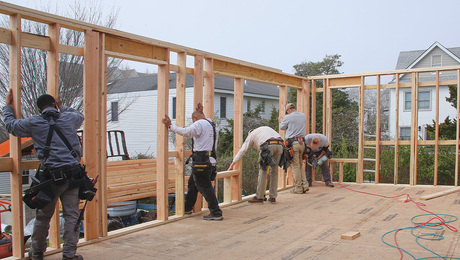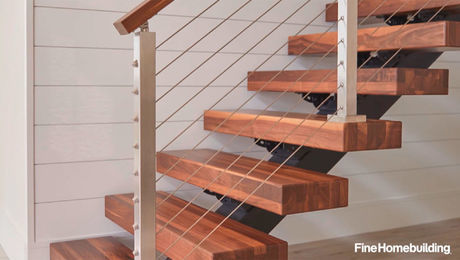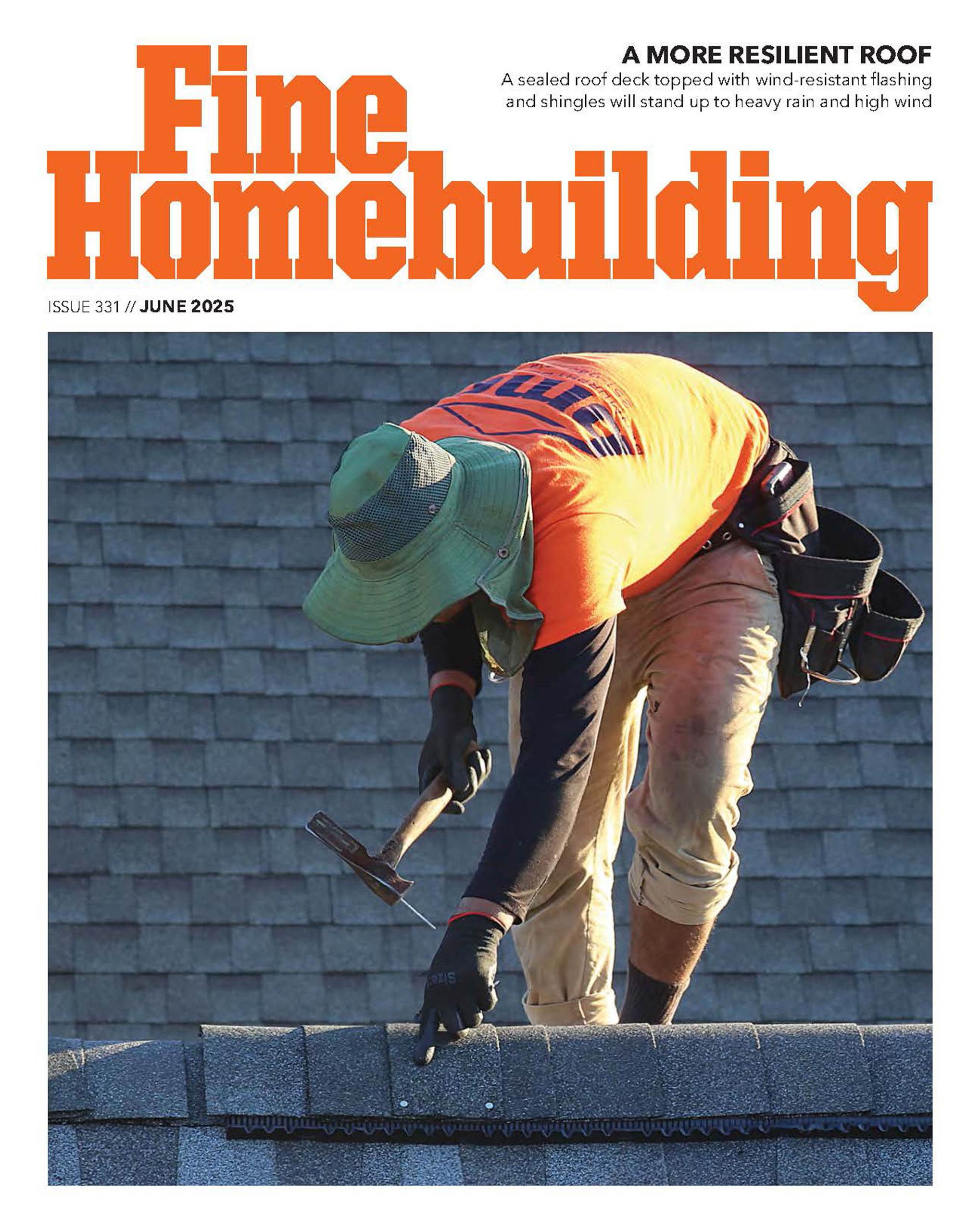I’m remodelling our kitchen, and we’ve decided to put in soapstone tile counters. The tiles (from Vermont Soapstone) are large (12x12x1/2) and flat, and with narrow spacing (I’ll use an unsanded grout in a close-to-matching color) we think it’ll be not all that different from a solid soapstone counter at a price we can afford.
There’s a bit of an issue with the substrate, though. I’m putting in a Kohler tile-in sink, and their instructions recommend a substrate of cement backer board over exterior-grade plywood. However, we bought some nice soapstone edging blocks from VS – they’re 12″ long to match the tiles and have a simple L-shaped profile with a bit of a chamfer on the outside corner. The front of the edging blocks only comes down 5/8″, so they won’t cover the combined depth of plywood and backer board. The guys at VS said they just use plywood as a substrate.
My concerns are strength (particularly for spanning the dishwasher), rigidity (don’t want my grout lines cracking), and water resistance. I’m thinking I’ll use exterior-grade tongue&groove plywood, and add extra blocking under it where it looks like it might be necessary (eg for the back of the dishwasher bay). That seems like it ought to suffice for the first two, but I’ve never done anything like this before.
For water resistance, I’m wondering if it might be a good idea to try to seal the top of the plywood first with polyurethane. I imagine the thinset would still grab adequately, and these tiles are pretty heavy – they’re not going to shift easily in any case.
Comments or suggestions?


















Replies
Whats the dimension on the other side of the L
can you flip the L around the other way so the 5/8 section is on the top and not on the side, Its going to give you what? 1 1/8 thick counter top? Personaly I think it will look a bit thin, maybe not
Edited 4/30/2003 7:17:39 PM ET by CAG
Thanks for the suggestion, but unfortunately it won't work; the front of the edging blocks are more than 1/2" thick, so they'd sit higher than the regular tiles if they were flipped around.
The fronts of the edging blocks are just about 1 1/4" (there's a little slop in the measurements I originally posted), which is definitely on the thin side as far as appearance goes, but I think will look fine in the room.
5/8" is not enough substrate for a countertop, you could easily have problems later with the 12" tiles breaking from improper support in the field.
Two thoughts
1) Use the appropriate substrate at least 1/2" ply plus 1/2" cement board or 3/4" ply and 1/4" hardi board and add a decorative piece below sandstone lip tiles (ie. harwood moulding stained to match cabinets)
2) Use appropriate substrate, forget about lip tiles and bullnose enough of the 12x12s to use as top edge of counter and cut tiles for front edge (that is the way I did my last soapstone top and it looks terrific...I used full 1-1/2" plywood substrate)
Bill
[Sorry to take so long to respond - I spent most of last week moving my stepdaughter out of college.]
#2 isn't a bad idea, but I suspect my wife wouldn't be happy leaving the edging blocks unused. Also, I don't currently have a router suitable for bullnosing the edges of the tiles, so there'd be another tool purchase involved.
I like #1. The cabinets are cherry with a clear finish, so it wouldn't be hard to match them - just rip some cherry boards and put clear poly on them.
Another similar alternative that I'm considering is ripping strips from extra tiles and running those below the edging blocks. Since they're thinner than the front of the edging blocks they'd be recessed a bit. I did a quick mock-up and thought it looked OK.
--
Michael
Anyone have pics of a finished tiled soapstone counter top, i'd love to see it in place....
John.
Here's an alternative. A bit different but it'll result in a thicker looking countertop. Bad news? It'll cost you more for additional nosing. then again, if you can make the layout work, you'll not remember the extra $12 a foot you had to spend on the extra nosing. Small change when looking at the big picture.
The top front edge of the nosing is chamfered, as you already described. The bottom front edge of the nosing has a slight roundover. You'll need to remove the bottom roundover by running the nosings through your tablesaw.
Kind of funny to be ripping stone on a tablesaw, but as you're aware, soapstone mills easily with carbide.
How much material to remove? As little a possible on the top piece. As required on the bottom, inverted piece, so the two pieces together cover your cement board and your ply underlayment. Don't forget to leave a space for the thinset. Still, the amount to rip depends on the layout. See attached pic.
The inverted piece of nosing may also need to have its 1 1/4" long by 1/4" thick "top" (now on the bottom) ripped. If your desired overhang is 1 1/4", leave it as is. If using just a 1" overhang, waste 1/4" of material. On the flip side, if you have a 1 1/2" overhang, you'll end up with a 1/4" gap between the bottom piece of soapstone and the face frame of the cabinet. No one will ever see it, but if you desire you can add a small piece of trim to the top of the cabinet's face frame to hide the gap.
Use black epoxy to seam the two pieces of soapstone together. Before epoxying, blue tape the faces of the nosings so epoxy squeeze out doesn't slop on the face of the nosing. Razor the excess epoxy off. If you end up with a minor bump of cured epoxy, you can sand it as well. It'll blend to a nearly invisible line after the soapstone has darkened.
If the two pieces of substrate add up to 1 1/4" thick (1/2" CB and 3/4" ply) and the two piece of nosing will only hide 1" thickness of substrate, see the "alternate" portion of the attachment. Just rabbet the bottom edge of the ply as required.
Quarter-inch tiles need all the support you can give them. Try for 3/4" ply and 1/2" CB, thinsetted and screwed. Sturrrr-dee.
Just another idea...
EDIT: for spellink
Edited 5/2/2003 10:28:31 PM ET by Mongo
Interesting, but how about this? Remove the material on the short leg so it sits flush with the tile, and mill off the roundover? (see attachment)
I would think your tile layout, depthwise, will still work, and it should give you enough height to cover the substrate.
It could work. My concern with that was that the amount of material removed, coupled with the chamfered corner, might weaken the stone at the corner.
With all these modifications we're proposing it'd probably be easier for him just to buy a bunch of offcuts and mill his own nosing.
I worried about the chamfer too, but it looks like an option, mudded to the proper substrate. The impression I got was the material is in hand, and we are in dealing with oops mode.
I wouldn't have said anything, but your post made me think about re-working the nosing, your thought made me think. Probably why I addressed my post to you, but I don't think soapstone tile is something I'll add to my bag of tricks for kitchen counters.
I know I am being unfair here, but all I can think of is this Nannygee guy, and how he can do everything cheaper than we do. Then you have the wooden top boys, way cool when you make a kitchen counter out of floor scrap. Let's face it, this soapstone top is going in for a fraction of what anyone would bid, and you get what you pay for.
Well, there are always compromises made somewhere, among materials, time, money, and labor. Sure, we'd rather have paid Vermont Soapstone or one of the other firms to make us a custom solid soapstone top. My wife and I really wanted this house, but the kitchen was a disaster, so we decided to go ahead with the remodel on a more limited budget than was ideal. Since it's our kitchen, we felt we had some latitude for experimentation - hence the tile compromise. If it doesn't work out, well, I can always remove it in a few years and put something else in.
If I were a pro working on someone else's house, I'd be more conservative. (And I'd have the substrate and edging figured out before I tore anything out...)
--
Michael Wojcik
Neat idea. I'm tempted, particularly as the nosing blocks I have don't have a roundover on the bottom corner, so there's no need to mill anything off - they fit together nicely as it is. I don't know if my wife will go for it, though, between having to order, buy, and ship another set of edging blocks and the time spent on the additional work of rabetting the substrate. We'll see.
--
Michael
I install granite slab countertops and frequently run across cabinets with plywood set into the top of the cabinets so the top of the ply is flush with the top of the faceframe. It might take some precise ripping of 3/4" ply but easy compared to some of the alternatives discussed.
One thing I tell all the contractors I work with is don't skimp on the ply. It drives me nuts when people put CDX ply from Home Depot on their cabinets and it bulges up in the middle creating a high spot that the rest of the countertop ends up having to conform to. Be sure to get a nice flat sheet of ply!
Karl